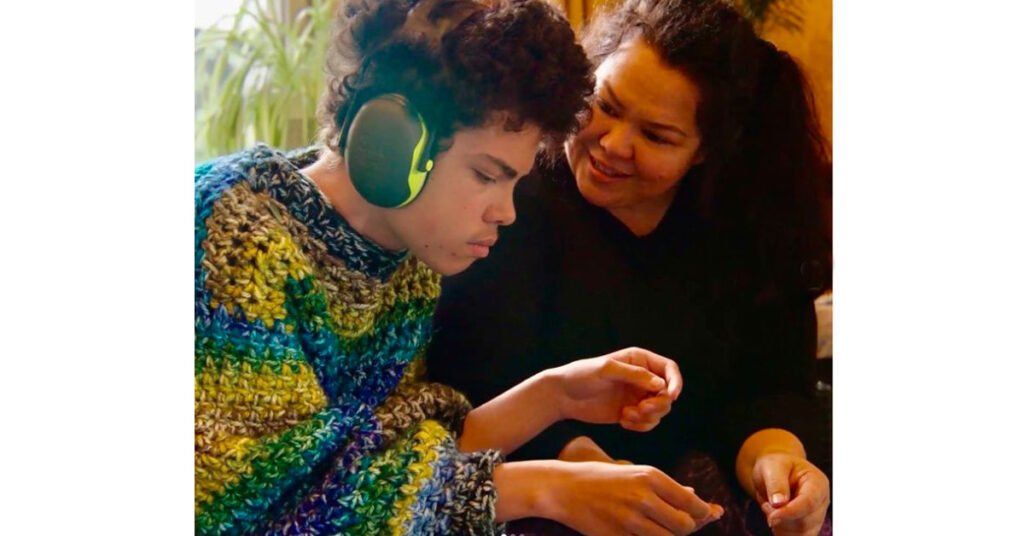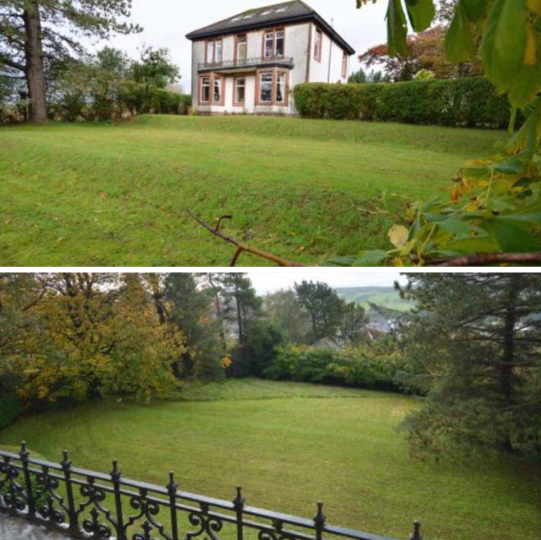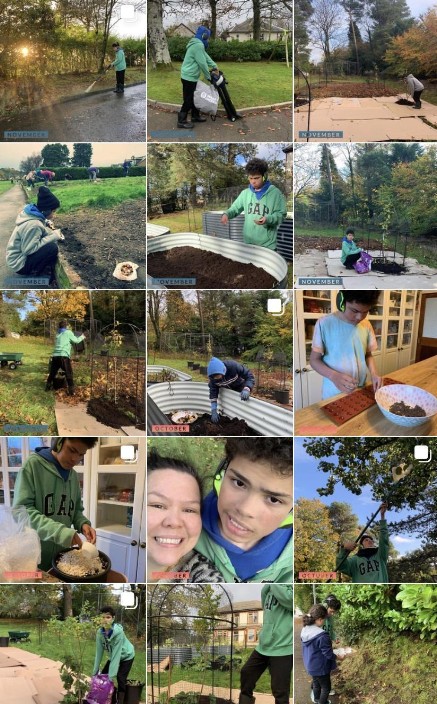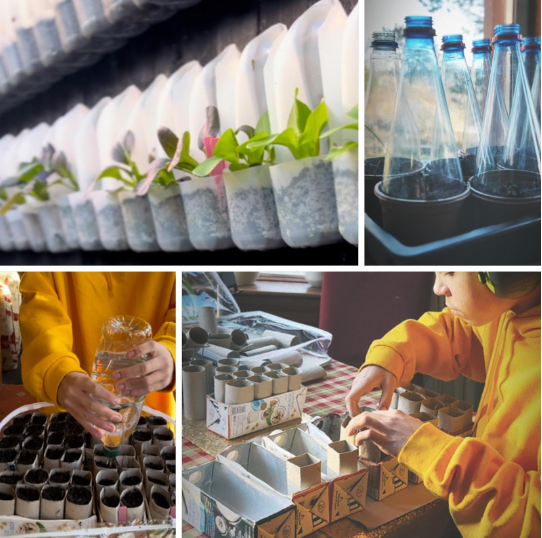
From plastics to purpose: choose greener with CoirProducts this July
It starts small. A plastic bag picked up on the way home. A plastic pot that seemed too convenient to resist. A bit of clingfilm,

For our Featured Grower series this week, we spoke to Katrina and Clayton
(@buildingafoodforest_scotland).
Katrina and Clayton live with their family in East Ayrshire, Scotland and share their daily life in the garden on instagram. They practice permaculture principles in the garden, reducing and repurposing waste whenever they can. Clayton completed the Grow and Learn Course with the Royal Caledonian Horticultural Society last year. This year he started the Level 2 Nurture Course. Clayton is 15, autistic, non verbal and has been home educated for the last 5yrs. Katrina tells us how they started growing, what they love to grow, and how gardening has benefitted them. She also shares with us how home educating in nature has helped Clayton thrive. Read on to learn all about Katrina and Clayton’s gardening journey.
How and when did you start gardening/growing?
We moved to this home in East Ayrshire, Scotland 4yrs ago in 2019. We knew we wanted to start producing food for the family to ease the food bills, especially fruit, but wasn’t totally sure where to start with a full grass lawn.
Peter completed the Permaculture Design Course online at Oregon State University, certified by the Permaculture Institute of North America and has designed the grounds using the 12 principles of permaculture design. We started with the fruit trees and fruit & nut bushes to get them established while we slowly but surely continue to build the area around them.
We thought we would see if Clayton would enjoy filling some pots and growing some seeds, as Clayton is autistic, non verbal, and has sensory processing disorder. He doesn’t like the touch of many things but at this point started to show interest in filling buckets of sand and mud from the garden whilst playing.
And that is where his love of all things gardening started for him. He is 15 and is now coming to the end of his 2nd year of horticulture courses designed for young adults like Clayton with the Royal Caledonian Horticultural Society.

What do you love to grow, and what are you growing this year?
We started off planting fruit and nut trees as these are the ones that take the longest to get established. They are mostly dwarf trees so they will be easy to harvest. This year we have just put the last of the fruit trees into the food forest area.
After the fruit trees we started on salads and herbs, and our vertical garden area was born, full of milk cartons pinned to a fence to use the space as best we could.
This year we will be concentrating on adding in our wind barriers around the borders, building on our successful veg we grew last year – butternut squash, corn and quinoa and adding more flowers to attract the bees and building up our two flower slopes.

Tell us about your process of working with plants – what are some important things to keep in mind when starting to grow your own, how do you work with plants you have no knowledge about?
The first permaculture principle is to observe, which is what we have been doing with our vegetables. We knew nothing about growing them and they are very different from finding a location for a fruit tree and popping it in the ground. There are many more factors to consider when growing vegetables. Scotland has such a short growing season you don’t always get it right.
For us, the two most important things to consider are: Firstly soil health, is it the right mix? Is it fully composted? Does it have good drainage? Secondly, what pests do you have in your growing area and how can you avoid them eating your crops? Research and trialling which methods work best for you is important.
What are some environmentally-friendly / sustainable gardening practices you adopt?
We try to follow the no waste permaculture principle, where everything that comes onto your land must be used.
We are working hard to produce as little waste as possible. Last year we did a 12 month eco swap challenge, each month swapping something out to reduce the waste of that product from shampoo to cleaning products, wrapping paper to clothing. It was very eye opening how much waste we had as a family of 5 that could be easier changed out with one simple swap. All the details are on our blog
We collect and use as much of our waste as possible to repurpose in the garden to give single use items multi uses or indeed use them up completely like cardboard, paper, toilet roll inserts, hair, coffee grounds. We even had neighbours save their milk cartons to use for growing in
Do you use coir products? If so, what are your experiences and what are the benefits of coir?
We have been using the erosion sheeting blankets to build paths on a muddy sloped area in our food forest. It goes down easy and has helped with the path usage, we no longer slip on the mud and can walk on it easily to work that area.
We also plan to add them to our two flower and lavender sloped areas, which we are growing on slopes, to stop soil erosion, keep the weeds and grass at bay. These seem to stop the snails and slugs too as it’s really rough texture, which they don’t like.

What do you enjoy the most about gardening/growing?
We all really love the excitement of getting up each day and walking around the areas to see what grew over the last day. It is a really mindful job looking after the land and something Clayton loves too. He has thrived in the garden, so much calmer and understanding of the world around him, he now picks up on the weather, the season changes and knows certain months means certain tasks to be done in the garden. We share daily what we get up in the garden and home on instagram.

On the other hand, what do you find the most challenging about gardening/growing?
The most challenging part has been having to wait to fill up the spaces, which is hard when you are excited to grow it all! There is only a small budget each year we can allocate to the garden, it is such a large area we are dealing with, feels like things are finally coming together after four years though
How has growing your own benefitted you?
Clayton is in his 5th year of being home educated. To be able to spend time with him everyday building this together has been (and still is) amazing. He has something to show for all his hard work and skills he is acquiring. Not only does Clayton benefit, it is a family thing. We deal with the day to day running of the areas but big jobs, multiple tree plantings, fence building, paths etc.. We are all out there, all 5 of us enjoying the garden together.
Who/what inspires you the most when it comes to gardening/growing?
Has to be Charles Dowding. He is always promoting no-dig techniques, experimenting and recording data with crops while always focusing on soil health.
What tips/suggestions would you like to share with other gardeners/growers?
Use what you have.
Start where you are.
There is always a way to just get started, if that is herbs on a windowsill in old juice cartons, strawberry plants in a hanging basket that once had flowers in, lettuce or pak choi in milk cartons on your fence. It doesn’t matter how small you start, it’s getting started that counts. You’ll be surprised once you start looking around your home what you can get started with.

Anything else you would like to add / highlight?
Surrounding yourself in nature, having something to look after or focus on changes your mental state. There is always another day, another crop, another season to look forward to.
You can find Katrina & Clayton below:
Instagram: @buildingafoodforest_scotland
Facebook: @buildingafoodforestscotland
Website: buildingafoodforestscotland.com
Youtube: @buildingafoodforestscotland

It starts small. A plastic bag picked up on the way home. A plastic pot that seemed too convenient to resist. A bit of clingfilm,

Because not all coir is created equal — and growers deserve better. For most, a coir brick looks simple. But for gardeners and growers, it’s













2025 © All rights reserved | Company number: 09536057













2025 © All rights reserved | Company number: 09536057